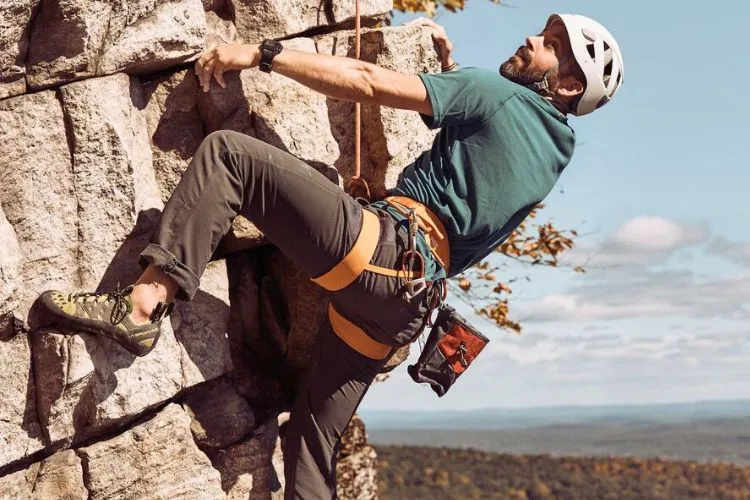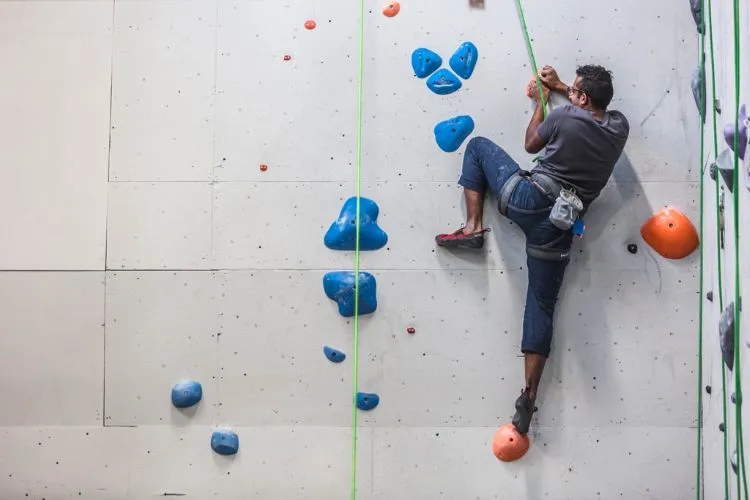In recent years, rock climbing has surged in popularity, evolving from a niche hobby to a mainstream fitness activity.
This shift is partly driven by the climbing segments’ inclusion in international sporting events and the opening of climbing gyms in urban centers worldwide.
But, can rock climbing replace the gym?
As more individuals seek alternatives to traditional gym routines, characterized by weightlifting and cardio machines, rock climbing emerges as a compelling option.
It combines physical exertion with mental strategy, offering a holistic approach to fitness that transcends the mere pursuit of physical strength or endurance.

This article explores the potential of rock climbing to replace the gym, considering its benefits, challenges, and the unique experience it offers compared to conventional workouts.
Can Rock Climbing Replace The Gym?
In evaluating whether rock climbing can replace the gym, it’s essential to compare the two in terms of the exercises they offer, the muscles they target, their accessibility and learning curves, and their overall costs.
Types of Exercises and Muscles Targeted

- Gym Workouts: Traditional gym workouts often involve a combination of cardiovascular exercises, such as running or cycling, and strength training, including free weights and machine-based exercises. This approach allows for targeted muscle development, focusing on specific muscle groups each session.
- Rock Climbing: Rock climbing provides a full-body workout, engaging the core, arms, legs, and back simultaneously. It emphasizes grip strength, endurance, and flexibility. Climbers often experience an increase in upper body strength and a more balanced muscle development due to the dynamic nature of the sport.
Accessibility and Learning Curve
- Gym Workouts: Gyms are widely accessible in urban and suburban areas, offering a familiar and controlled environment for fitness. The learning curve for gym equipment can vary, but personal trainers and structured classes help beginners.
- Rock Climbing: Access to rock climbing can be more limited, often requiring specialized climbing gyms or outdoor climbing areas. The learning curve is steeper, with climbers needing to learn techniques and safety measures. However, many find this learning process rewarding and integral to the climbing experience.
Cost Comparison
- Gym Workouts: Costs can vary widely but typically include monthly membership fees. Additional costs may include personal training sessions, classes, and transportation.
- Rock Climbing: Climbing gym memberships often cost more than traditional gyms due to the specialized equipment and facilities. Initial costs also include purchasing climbing shoes, a harness, and possibly a belay device. However, once equipped, climbers can also pursue outdoor climbs without ongoing costs.
Rock climbing and gym workouts offer distinct benefits and experiences. While rock climbing provides a comprehensive, engaging fitness routine with a strong community aspect, traditional gym workouts offer more targeted muscle development and widespread accessibility.
The choice between rock climbing and gym workouts ultimately depends on individual fitness goals, interests, and the value placed on the social and mental aspects of exercise.
Considerations for Replacing the Gym with Rock Climbing
Deciding to replace traditional gym workouts with rock climbing involves several considerations. These factors can influence an individual’s ability to fully transition to climbing as their primary form of exercise.

Safety Concerns
- Gym Workouts: The controlled environment of a gym minimizes risks. Equipment is designed for safety, and staff are usually on hand to assist with proper use.
- Rock Climbing: Climbing carries inherent risks, including falls. Proper training, awareness, and adherence to safety protocols are crucial. Indoor climbing gyms offer a safer environment for beginners compared to outdoor climbing.
Skill Progression and Challenges
- Gym Workouts: Progress is often measured by increases in weight, repetitions, or endurance. Plateaus can be broken with new exercises or increasing intensity.
- Rock Climbing: Progression involves mastering more difficult routes and improving technique. Climbers face physical and mental challenges, including overcoming fear of heights and learning to trust their skills and equipment.
Seasonal and Geographical Limitations

- Gym Workouts: Gyms are typically unaffected by weather conditions, making them accessible year-round.
- Rock Climbing: Outdoor climbing is subject to weather and may not be feasible in all seasons, depending on the location. Indoor climbing gyms mitigate this but may not be available in all areas.
Community and Social Aspects
- Gym Workouts: While gyms can be social spaces, interactions are often limited. Group classes offer a more communal experience.
- Rock Climbing: Climbing has a strong community aspect, with climbers often working together to solve routes and share techniques. This camaraderie can be a significant draw for those seeking a more social fitness experience.
Variety and Enjoyment
- Gym Workouts: The gym offers a wide range of exercises and equipment to keep workouts varied and engaging.
- Rock Climbing: Climbing routes are constantly changing, offering new challenges. Many find the problem-solving aspect of climbing routes adds an enjoyable mental component to their physical workout.
While rock climbing offers a unique blend of physical exercise, mental stimulation, and social interaction, it may not be the perfect fit for everyone as a complete replacement for the gym. Individuals must consider their personal fitness goals, safety concerns, and the enjoyment they derive from each activity.
For some, a combination of gym workouts and rock climbing may provide the best of both worlds, ensuring a well-rounded fitness regimen.
Conclusion:
The question of whether rock climbing can replace the gym as a primary form of exercise is multifaceted, depending on individual preferences, fitness goals, and the value placed on the mental and social aspects of physical activity.
Rock climbing offers a comprehensive workout that challenges the body and mind in unique ways, fostering community connections and presenting new challenges with each climb. It engages multiple muscle groups, enhances problem-solving skills, and can significantly boost mental health.
However, traditional gym workouts provide targeted muscle development, greater accessibility, and a familiar routine that can be easier for beginners to adopt. The gym’s controlled environment also offers a level of safety and predictability that outdoor climbing or even indoor climbing gyms cannot always match.
Ultimately, the decision to replace the gym with rock climbing should be based on personal preferences, lifestyle considerations, and fitness objectives.
For many, a hybrid approach that incorporates both climbing and gym workouts might offer the best balance, allowing for the targeted strength and conditioning of gym exercises combined with the dynamic, full-body engagement and community spirit of climbing.
Rock climbing and gym workouts are not mutually exclusive but complementary components of a diverse and fulfilling fitness regimen. Embracing the strengths of each can lead to a more balanced, enjoyable, and effective approach to physical fitness and well-being.


